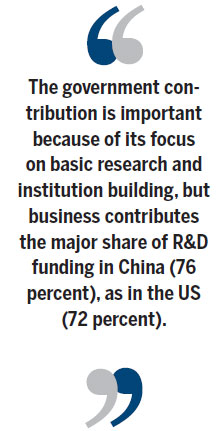Innovation rolls on, and there's a lot more
Updated: 2014-06-27 07:30
By Bruce McKern and George Yip (China Daily Europe)
|
|||||||||||
The notion that chinese do not innovate is false, but more effort needs to be put in
Over the past 10 years, a key priority of the Chinese government has been the development of a National Innovation System.
The goal is to build an innovation "ecosystem" based on indigenous innovation by strengthening the top universities and government research institutes in priority fields and promoting innovation in private enterprise and state-owned enterprises. This is an important priority for China's technological future.
What's the state of innovation in China today? Let's look first at the investment in the National Innovation System. Government and business investment in research and development in China has been steadily growing each year and recently reached 1 trillion yuan ($161 billion; 118 billion euros) per year, or 1.9 percent of GDP, which is close to the percentage spent by the European Union.
China is investing 40 percent as much in R&D as the United States, in line with the relative size of its economy.
The government contribution is important because of its focus on basic research and institution building, but business contributes the major share of R&D funding in China (76 percent), as in the US (72 percent).
The results of this investment are remarkable. First, the National Innovation System has matured and become more productive. More than 100 science and technology parks have been built, and they include government research institutes and universities, which are magnets for local entrepreneurs. Multinationals have located some 1,500 R&D centers in the larger science and technology parks and they increasingly see the Chinese innovation ecosystem as an incubator for new ideas.

Second, China has advanced rapidly on key measures of innovation output. In scientific publications it now accounts for 14 percent of the world total. In computer science and chemistry, China ranks first globally, and it's second in mathematics, physics and astronomy. Another measure, of patents, shows even more spectacular growth. The number of invention patent applications in the country in 2012 reached more than 650,000, more than in any other country, including the US.
The conventional wisdom outside China (and often inside) used to be that Chinese companies are copiers and not capable of innovating. That view is outdated. Chinese executives we interviewed are often more aware of the need for innovation than multinational corporations operating in China. Many have created innovative products, processes and business models: Haier, Huawei, Alibaba, Baidu, Tencent, Mindray, Neusoft, and Goodbaby are just some of the better-known examples.
One reason for the mistaken belief that the Chinese don't innovate is confusion about what is meant by "innovation". Certainly, few Chinese companies are introducing radical, game-changing products such as the iPhone, but they are brilliant at introducing products that are "fit for purpose" and not needlessly elaborate. They have been very quick to improve products as customer needs become more sophisticated. These companies are masters at incremental innovation, which is what China has needed up to now. They have a base of knowledge and experience from which they will surely create more radical innovations.
While the state of innovation in China is sound, there is more to be done in three main areas.
First, Chinese firms are not strong in patents lodged through the more rigorous process of the Patent Cooperation Treaty, an international patent law agreement.
China's share of such patents is under 10 percent, about the same as Germany's. As Chinese firms gradually expand into Europe and the US, they will need strong technologies to support them. More Chinese companies should use the PCT process and also take out patents in foreign countries.
Second, the more successful companies are those whose innovations are continually being tested in the market by customers and competitors. Some firms gain short-term benefit from government support or protection, but they will be stronger in the long run if they have to compete based on their capabilities. If the reforms initiated by the government continue the process of opening up markets to competition (including access to funds) innovation will continue to flourish.
Third, multinational corporations want to be more deeply embedded in the Chinese innovation ecosystem. But they currently provide less than 2 percent of the total funding for R&D and account for only 18 percent of local patent applications. They encounter many obstacles to become a full partner such as IP protection and non-national treatment. The market-oriented reforms under way will be even more effective if they establish a more level playing field for these corporations.
In a report to the 12th National People's Congress on March 5, Premier Li Keqiang outlined comprehensive plans for strengthening competitiveness and innovation, addressing many of these points. This bodes well for China's future state of innovation.
Bruce McKern is a visiting fellow at Stanford University's Hoover Institution, and former co-director of the Centre on China Innovation at China Europe International Business School (CEIBS). George S. Yip is professor of strategy and co-director of the Centre on China Innovation at CEIBS. The authors are writing a book on innovation in China, based on their three years of research.
(China Daily European Weekly 06/27/2014 page9)
Today's Top News
Prime London properties lure investors
FIFA bans Suarez for 4 months
Tycoon criticized for charity in NY
50 trapped Chinese back to Baghdad
Northern Iraqis flee their home, avoiding Sunni millitans
DPRK test-fires newly developed missiles
RIMPAC drill not window-dressing for China-US ties
Li puts China-UK ties on new level
Hot Topics
Lunar probe , China growth forecasts, Emission rules get tougher, China seen through 'colored lens', International board,
Editor's Picks

|

|

|

|

|

|





